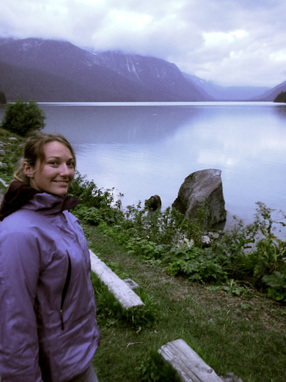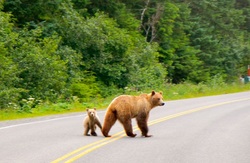 Mandrew with a humpy male fish
Mandrew with a humpy male fish The life of a salmon is a pretty intriguing thing. Pink salmon hatch during the winter and soon after make their way to the ocean where they spend 18 months feeding on plankton, small fish, crustaceans & squid. Once they've eaten their last meal, they make the epic journey back upriver, drop off their eggs & sperm, and then ... die.
For whatever reason, pink salmon are shiny and silver-coloured while living in the ocean, but once they start their sex death journey they turn pink and the males develop a large hump on their back and a hooked upper jaw. Seriously, I'm not making this up.
What I find really interesting is the way the salmon affect their environment. By feeding like crazy in the ocean and then dying in their freshwater spawning grounds, the fish transport an incredible amount of nutrients upriver. This is extremely important to the surrounding wildlife (bears, eagles, etc.) as well as the plant life that grows along the river. Cue the Lion King's "Circle of Life" - naaaaaaaaaaaaaaaaaaaaaaaaaaaaaaaaa, sequenyaaaaaaaaaa, mamameeeeeecheeewawaaaaa....
The fishing itself is quite different from any other fishing I'd experienced. Because they're no longer interested in eating once they've begun their journey back upriver (one track mind?), it's pretty tough to convince them to bite your lure. You can either use a lure that resembles roe (fish eggs) drifting along the bottom of the river in the hope that an altruistic salmon will take it in its mouth and try to secure it to the riverbed, or you can cast & reel with a shiny lure in an attempt to annoy a fish into biting it. We went with the latter strategy and had decent luck, though we still caught many more fish "by accident" rather than by enticing them to bite. It's pretty crazy to think that there are so many fish in the river that you can't avoid hooking into their bodies (like shooting fish in a barrel!), and unfortunately the rules force you to release any fish caught by "snagging". Being the honest folk we are, this meant we kept only four fish but released over a dozen others.
 Chelsea posing with "BMJ", a 28 year old sow
Chelsea posing with "BMJ", a 28 year old sow As ridiculous as this all sounds, it's completely safe (especially if you're not the slowest runner in the group). All joking aside, there really is very little to worry about, and any doubts are quickly dispelled by the ever-present Parks & Wildlife staff as they patrol the river and keep an eye on the bears (and the tourists). At no point did we see a bear without first being notified that there was one approaching and that we could keep on fishing; they'd come warn us again before it got too close. In our few days there we got to know some of the staff and a couple of the bears. The one with Chelsea in the photo above was well known - this was her 28th year fishing on the river - and her daily trek down the river and through the campground was like clockwork.
 BMJ munching on some salmon sushi
BMJ munching on some salmon sushi During high tide there were also a number of seals that would make their way in from the nearby saltwater to feast. In fact, we found that the best time to fish was just as the tide reached its high point, since by then the seals had chased a fresh batch of salmon upriver for us to try and annoy.
Although this was my third trip to Haines (and Chelsea's umpteenth) I'd definitely come back if I get another opportunity - it's just too damn magical.

 RSS Feed
RSS Feed